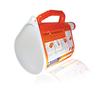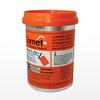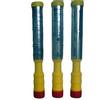Let's take a moment to review everything you need to know about distress flares! The following information was compiled from Transport Canada and flare manufacturer Orion.
About Flares
Use flares only in times of real distress. Before purchasing, make sure they are approved by Transport Canada. There are four types of approved pyrotechnics: A, B, C and D.
Aerial flares should be fired at an angle into the wind. With a high wind velocity, lower the angle to a maximum of 45 degrees. Pyrotechnics are valid only for four years from the date of manufacture, stamped on each flare. To dispose of your outdated flares, seek advice from your local fire department, law enforcement agency or Transport Canada Centre.
Store flares vertically in a cool, dry location (such as a watertight container) to help them retain their efficiency, but keep them accessible in case of an emergency.
 |
Rocket Parachute Flares (Type A)
|
 |
Multi-Star Flares (Type B)
|
 |
Hand Flares (Type C)
|
 |
Smoke Signal (Type D)
|
Principles of Signaling
The purpose of distress signaling is: first to attract attention and second, to provide a homing signal to guide the responding party to your craft. Remember, nothing can happen until someone's attention is attracted. The most effective distress signals for attracting attention are aerial flares and parachute flares because they are moving, spectacular and cover a large sighting area. Once help is on the way, handheld red signal flares, orange smoke signals and orange distress flags serve as beacons helping rescuers to pinpoint your position and keep them on course.
Aerial Signals
Aerial flares should be fired after sighting or hearing a potential rescue vessel. To attract attention to your distress situation the U.S. Coast Guard recommends that you fire 2 aerial flares, one immediately after the other, so rescuers can confirm the sighting and the direction of the signal. Parachute flares do not need to be fired in twos since a single parachute flare has adequate burn time(25 to 30 seconds) to confirm sighting and position.
Hand-Held Signals
Hand-held signal flares are intended as homing signals to pinpoint your position. Surface to surface sighting range on water is approximately 3 to 5 miles, depending on boat elevation. If a rescuer is 5 miles away and running at 20 miles per hour, it will take 15 minutes to reach you. Therefore, you should have at least 12 minutes (total burn time) of signals onboard to maintain a strong homing signal until help arrives.
When to Signal
Aerial flares, and other "one-time" signals, should be fired only after sighting or hearing a potential rescuer. Experts recommend that once an aircraft has been sighted, one flare should be fired, then a second flare fired immediately after the first to let search teams confirm the sighting and direction of the signal. Remember, search and rescue missions often establish grid search patterns, which means you may see the same aircraft 2 to 3 times coming from different directions. Do not waste aerial flares if the aircraft has initially passed by you. Carrying extra pyrotechnic signals will improve your chances of being sighted.
4 Rules of Signaling
- Conserve your signals until you are reasonably sure of being sighted. Wait until you see or hear a vessel or aircraft before using "one-time" signals.
- Stay with the boat if it is safe to do so. A boat is easier to spot than a swimmer.
- U.S. Coast Guard approved marine signals improve your chances, but anything that works is good. USE COMMON SENSE! Shout, flash your running lights, wave a piece of clothing, use your windshield as a mirror, flash a flashlight, ANYTHING that's available to attract attention. Above all, DON'T PANIC!
- Familiarize yourself with your signals before you leave shore. Time is important in any emergency and shouldn't be spent reading instructions.
































